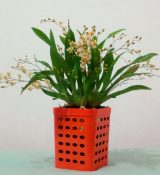Brassavola Orchid Plant Care
Author: adminNo Comments
Care and Culture, Growing Indoors
These star shaped orchid species (known as Brassavolas), are native to the flat plains of Central America and tropical South America. They are epiphytes (plants that grow on top of other plants, but do not use them as a source of nutrients or water; taking their nutrients from the air), and a few are lithophytes (lithophytes feed off moss, nutrients in rain water, litter, and even their own dead tissue).
Brassavolas’ can be grown in the home but are more often grown in greenhouses outside, in the home (in greenhouses), or under lights. In the following paragraphs, I’ve listed many tips that should help guide you in growing your own Brassavola orchid plant in any method you choose.
A single flower bud (or a cluster of a few flowers) at the top is accompanied by succulent leaves that grow on an elongated pseudo bulb (A thickened portion of the stem of many orchids functioning as a water and food storage device). The flowers usually vary from 1 to 5 inches in diameter, and range in colors from a greenish-white, to white, to yellow with brown markings.
Brassavola Orchid Care Preferences
- Humidity – Brassavola Orchids grow best with a humidity tray underneath them and 60-70% humidity.
- Light and Air – Brassavolas’ prefer light that is similar to the Cattleya orchids’ light requirements; bright light; if you have a light meter, anywhere from 2000-3000 foot candles is ideal. Keep an eye on the air circulation; this aspect is important when caring for all orchids.
- Watering – Don’t let your Brassavola dry out between waterings; the plant isn’t partial to this. You’ll want to water this orchid plant on a regular basis, just before it is near drying out.
- Fertilize – I’d suggest fertilizing your Brassavola orchid 3 out of 4 waterings with a weakened (diluted) Orchid fertilizer solution.
- Temperature – Try to keep the temperature above 55-60 degrees F; orchids don’t like temperatures dipping below this. During the day they prefer warmer temperatures.
- Potting and Repotting – You’ll want to repot your orchid plant every two to three years as necessary with medium to large bark. Brassavolas’ also often like to be mounted on a piece of bark or a tree fern.


Ask an Expert
Questions about orchids?
Our experts love a challenge!
Photo of the Week
Submit your photo to be featured on the blog!
More Photo of the Week Winners
Submit Photo







